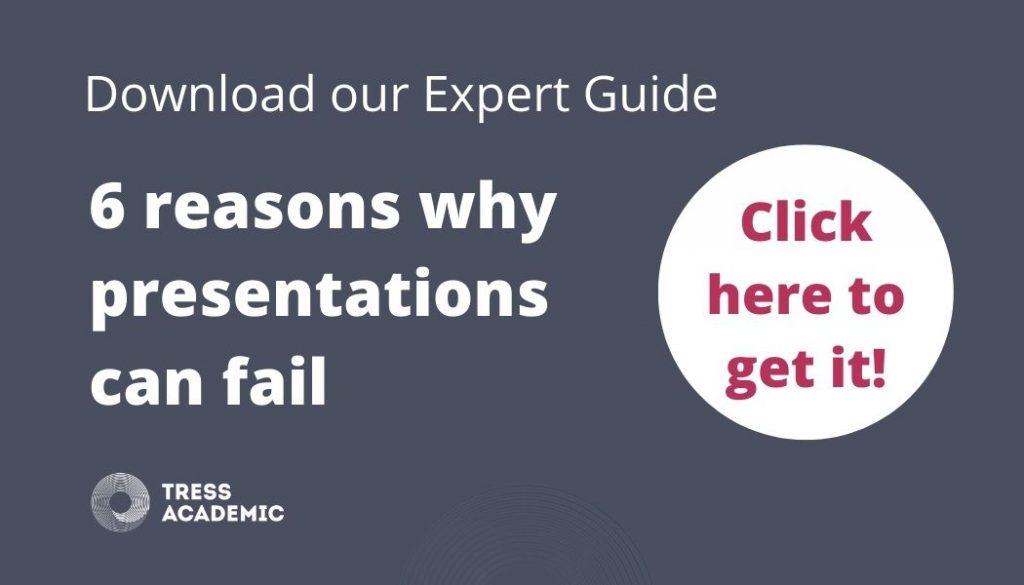Are you going to present your research to an audience soon? Do you want to deliver a great talk that your audience will remember? Whether you’re presenting face-to-face in front of a live audience, or delivering a virtual talk at an online conference, apply our 5 killer tips to make a great impression and deliver a stellar talk.
The possibilities of how to present your research to an audience have changed a lot throughout the pandemic. Conference talks were not delivered in front of an audience sitting in a presentation hall, closely watching and listening to you. Suddenly, you were faced with delivering it to a virtual audience from around the globe following you on their computers, often without you seeing who’s watching. In the post-pandemic time, this new form of presenting will likely remain.
But the pandemic has not changed what your audience thinks makes a good or not-so-good talk. Sure, the mode of delivery is more flexible than it was before, but there are universal principles that will help you to deliver well in the virtual as well as the in-person environment. Here, we provide you with 5 of the most important tips that—if you apply them—can improve any presentation substantially, whether virtual or not.
Tip #1: Tell your audience what they will learn from you
In any scientific talk, you’re educating your audience. You’re not just reporting your project—you have a specific intention with your talk. It would be boring for your audience to just hear what you did in the project. They all know how projects work, and technical details following each other can easily get tiring. Make sure that the purpose of your presentation, which might address a specific research question, a specific problem, or any lack of clarity in your field of research that you address, is explicitly expressed in your talk.
You’re guiding the thoughts of your audience while presenting. You want them to understand what you did, why you did it, what the great findings of your research are, and what they mean. To get your audience on track, you need to provide direction from the start and throughout your talk. What you want them to learn and how you’re going to tell them this message must be clearly presented.
Tip #2: Tell a meaningful and memorable story
When you’re presenting, you’re the expert. There’s no one in your audience who knows your work better than you do. You’ve spent a lot of time planning and conducting your research, thus you know all the details, and all numbers and facts mean something to you. That’s not the same for your audience. Even peers from your field will not know what you know because they haven’t been part of your project.
In a conference talk, there’s not a lot of time to explain everything in full detail. It is very tempting to leave out anything not directly related to your research results so you have more time to present ALL your results. But in reality, such a presentation risks falling apart. You need to build a bridge for your audience that helps them understand where you are and what you do. The best way is to limit your presentation to one aspect of your work, keep it simple, and introduce and explain it well. Instead of overloading your talk with impressive jargon, complex data, charts, and loads of facts, reduce the amount of information, focus on your message, and communicate visually. That way, your audience has a chance to understand the purpose of your work, and will remember the story you tell them.
Tip #3: Focus on the interests and knowledge of your audience
Any scientific talk is only as good as its impact on the audience. A well-prepared and well-delivered talk is hardly recognised as such if it is of low relevance to the specific audience. The people in your audience are folks like you and us, they have interests and preferences, they like some things more than others, and think that some things are more interesting than others. If you ignore the preferences and knowledge of your audience and prepare a talk for a general audience, you’ll have a hard time leaving a great impression.
You’re the expert in your field. People come to hear your expertise. But don’t talk and present like an expert. Make it easy for your audience to follow, and impress them with how easy it is for you to share your expertise. What parts of your work are the most interesting and relevant for this specific audience? Show them that what you do is relevant to them! Focus your presentation on these aspects, and reduce or leave out anything that is of less interest to them. You should adjust to your audience, not your audience to you.
Tip #4: Interact with your audience and relate to their research life
A scientific conference presentation is not a movie to watch, and it’s not a text that is read—it’s a live event with the chance to directly address and interact with your audience. And this is what your audience prefers: interaction with you. They want to see that what you do relates to them, now, as you talk. Otherwise, they could watch a movie or read a paper, both of which could be more detailed and informative than your talk, but they decided to come to your talk instead.
Think about how you can build a bridge to your audience. Any audience that is allowed to interact with a presentation is far more attentive. They’ll appreciate that you made an effort to engage with them. Therefore, address them directly, ask questions, ask for comments, provide time to think about (rhetorical) questions, use interactive tools to get them involved, open for questions (not only at the end). Show your audience that you’re interested in them; it’ll make you more interesting to them as well.
Tip #5: Offer something to take home
Any presentation will be considered positive when the audience feels it was worth the time and effort spent, and when they feel that they’ve got something out of it. There are many presentations where you hear interesting statements and see nice slides but in the end, you hardly remember anything, certainly not a few days after you heard them.
You can do two things to make sure that your audience will remember a great talk from you: First, focus your entire talk on this one message, and present it clearly again at the end. In the end, all the lines of your talk should come together and lead to the message that you want people to remember: the take-home message. Be explicit here!
Second, you don’t need to stop at providing a take-home message. Why not offer those people in the audience who are a bit more interested in your topic a follow-up? What about referring to a website where they can find more information, a recent publication, or a short leaflet with the key summary that they can download from your website? Now is the moment where some people in the audience get curious and would be happy to hear more from you. Don’t miss this chance to connect with them beyond this talk: offer some kind of follow-up!

Conclusion
Presenting research virtually or live is a challenge, we know, but you can easily master this challenge by following the 5 tips presented here. It is not about having the coolest results to deliver—it’s about showing that you like your work, that you respect your audience, that you’re able to direct them to understand your message—this can be done with not-so-super-fancy-results. As long as you follow the principles outlined above, you will receive a great audience reaction. We’d love to hear how your next presentation goes! Send us a message and let us know at info@tressacademic.com.
P.S.: A 6th killer tip for a good presentation comes from our own way of learning how to present well: Watch other presentations and learn from them! In particular, there’s a lot to learn from two types of presentations: First, the really poor ones—those presentations that feel like a waste of your time. They are not if you analyse for yourself what would have helped the presenter make a better presentation and keep this in mind for your next one. Second, you can also learn from the stellar presentations—the ones that impress you with their clarity and the power of their messages and communication styles. Analysing these presentations is a bit more difficult because it all looks so perfect and smooth, and you think they are just a highly gifted presenter, a natural star. Sit down and think for a while on what you liked in this presentation, and how you could implement any of it into your presenting style.
Relevant resources:
- Blog post #44: What to present from your PhD study when you don’t have a lot to show yet?
- Blog post #30: Questions from the audience you should be prepared to answer
- Blog post #26: First conference presentation? 17 life-saving tips
- Blog post #16: Your job talk: 5 tips to make it a success!
- Blog post #3: How to cope with stage fright?
Relevant courses and services:
- 1-day course: Presenting successfully at virtual conferences
- 3-day course: How to present at international conferences
- 1-to-1 advice: Presentation Check
More information
Do you want to present successfully at conferences?
If so, please sign up to receive our free guides.
Photo by Brooke Cagle at unsplash.com.
© 2021 Tress Academic
